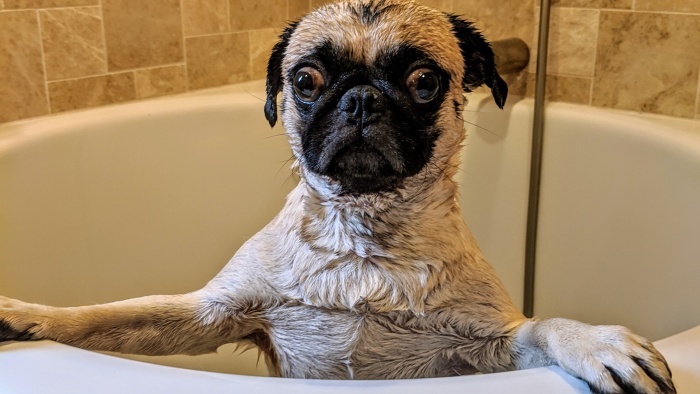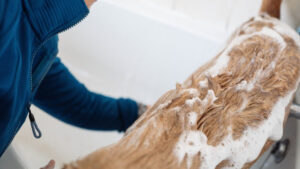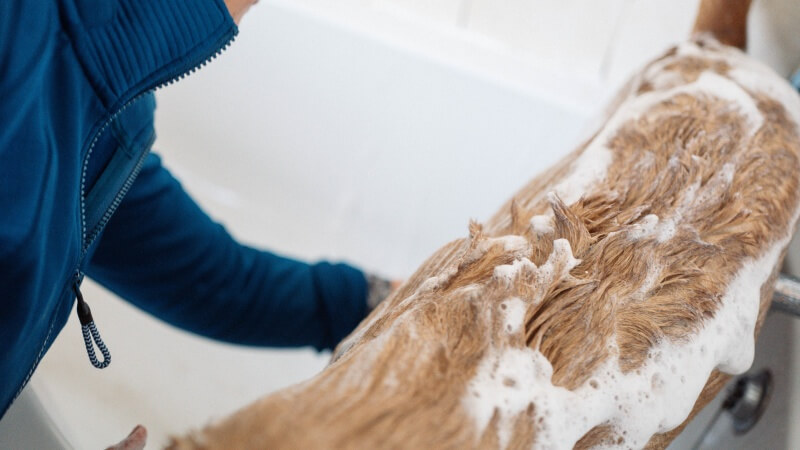
White Long Haired Dog: 13 Breeds
After much deliberation about your next pet, you’ve decided on a white long haired dog, large in size. Doesn’t that sound like you’re aiming to

To effectively remove fleas, a common nuisance for dogs, cats, and their owners, it’s crucial to understand these pests. Fleas are tiny, blood-sucking insects that, despite being wingless, can leap up to 13 inches, about 200 times their body length.
These pests are not only minuscule but also fast, making their presence often unnoticed initially. The sensitivity to flea bites varies among pets.
The insects’ saliva triggers allergic reactions, causing itchiness. Signs of infestation include increased scratching in pets, the presence of scabs, flea dirt, or a salt-and-pepper-like appearance in their bedding.
Fleas don’t exclusively target animals; they can bite humans too, leaving itchy welts. They are potential carriers of diseases like typhus and plague and can infect cats with “cat scratch disease,” which can then be transmitted to humans. Moreover, fleas can spread tapeworms to both animals and people.
Treating your dog or cat for fleas is imperative. Eradicating these pests from your pet reduces the frequency of itchy, irritating bites and helps keep your home flea-free.
Should you spot fleas on your pet or within your home, immediate action is crucial. Fleas have a rapid reproduction rate, and a small number can swiftly escalate into a significant infestation, posing trouble for both you and your pets.
The following are several methods and strategies to effectively eliminate fleas.
Initiating flea eradication often begins with bathing your pet. Utilizing lukewarm water alone, or combined with gentle soap, can aid in removing fleas from your pet’s fur and skin. Dish soap is effective in drowning adult fleas.

However, before opting for flea-specific shampoos or similar products, consult your veterinarian. These products might deplete natural oils in your pet’s fur and cause skin dryness.
If your pet suffers from flea allergy dermatitis, as your vet might term it, or has open wounds or irritated areas on its skin, be cautious. Certain ingredients in flea products could aggravate skin irritation and infections.
Although beneficial, bathing is not obligatory for your pet. If you’re concerned about your pet’s reaction to a bath, it’s acceptable to forego this step. Overbathing should be avoided.
Consult your vet for tailored advice – some pets might require daily baths in cases of severe infestation, while others may need it only weekly, and the choice may also be influenced by the type of shampoo used.
Fleas, being small and quick, are challenging to catch, yet using a flea comb is an effective way to remove them from your pet’s fur. Dipping the comb in a mixture of water and dish soap aids in trapping fleas, preventing their escape.
A flea comb’s teeth are spaced to efficiently capture fleas while allowing your pet’s fur to pass through smoothly. It’s also effective in eliminating flea feces, or “flea dirt,” which appear as tiny, dark pepper-like specks.
Additionally, the combing process can help in removing flea eggs from your pet’s fur. While combing, especially focus on the neck and tail areas, as fleas often feed there.
To enhance the effectiveness of this process, using a hair dryer in a cool and gentle setting after combing can help in drying your pet’s fur and dislodging any remaining fleas or eggs.
These tiny pests, ranging in size from a poppy seed to a sesame seed, are typically brown or reddish-brown.
When you spot a flea on the comb, immerse it immediately in hot, soapy water to exterminate the flea. Avoid attempting to squash fleas manually. Due to their quick jumping ability and resilience, they are challenging themselves to kill by hand.
Although apple cider vinegar cannot eliminate fleas, it can serve as a deterrent. Fleas are averse to both the scent and taste of apple cider vinegar, making them less likely to infest your pet’s fur.

Mix apple cider vinegar with water and pour it into a spray bottle. If spraying is distressing for your pet, soak a brush in the solution and groom them, thereby distributing it through their fur.
For pets with a flea history, use a flea comb weekly to meticulously check your companion. Continue this practice until you are confident that both your pet and home are completely flea-free.
Cats intensify their grooming when afflicted with fleas, a behavior that’s more than just alleviating itching. Research indicates this increased grooming aids in flea removal. Dogs, too, often groom themselves more when they have fleas.
Generally, this is harmless, but if your pet starts to excessively nip, chew, or scratch itself, leading to noticeable hair loss, shedding, or the appearance of red, inflamed, or bloody skin, contact your vet immediately. These symptoms could indicate an infection or flea allergy.
Bear in mind, that fleas may not always be visible on your pet, even if flea bites have been confirmed by a vet. Fleas inhabit carpets, bedding, and other surfaces in your home, jumping onto pets (and occasionally humans) for feeding, but typically not residing on them post-feeding.
If you’re uncertain about flea infestation, consult your vet for a definitive diagnosis.
While fleas are not typically an urgent medical issue, managing them effectively often requires a veterinarian’s intervention. Prescription flea treatments, such as collars, and oral, or topical medications, are usually the most effective approach. However, immediate veterinary attention is necessary if you observe any of the following in your pet:
These symptoms could indicate a more serious condition like a tapeworm infection. Promptly addressing these signs can help in restoring your pet’s health and well-being.

Alongside treatments, there are effective preventative methods to keep fleas at bay. Regular use of preventative flea medications is a key step in maintaining a flea-free pet.
These medications come in various forms, including collars, oral tablets, and topical solutions, and work by continuously repelling or killing fleas before they can establish an infestation.
Maintaining cleanliness in both your pet’s living environment and your home is equally crucial.
Regularly washing your pet’s bedding, vacuuming carpets, and cleaning furniture can significantly reduce the risk of flea infestation. Fleas thrive in warm, humid environments, so keeping your home dry and well-ventilated can deter their proliferation.
It’s also advisable to regularly groom your pet and check for fleas, especially after they have been outdoors or in contact with other animals. This not only helps in early detection of fleas but also strengthens the bond between you and your pet.
Finally, keeping your yard or outdoor spaces clean and free from debris can minimize the likelihood of flea infestations. Fleas often lurk in tall grasses and shaded areas, so keeping your lawn trimmed and minimizing clutter can make your outdoor space less hospitable to these pests.
These preventive strategies, combined with regular veterinary consultations, form a comprehensive approach to managing and preventing flea infestations, ensuring your pet’s health and comfort.
To remove fleas effectively from your pet, a combination of diligent care, appropriate treatments, and proactive preventative measures is essential.
This approach ensures not only the immediate relief of your pet from these persistent pests but also a long-term solution to maintain a flea-free and healthy environment for both your pet and your household.
FAQ: Can fleas become immune to certain treatments?
Fleas, like many pests, can develop resistance to certain chemicals over time. This is why it’s important to rotate flea control products and consult with a veterinarian for the most effective and current treatments.
FAQ: Are there any natural remedies that are effective against fleas?
While natural remedies, such as diatomaceous earth and certain essential oils, may offer some relief, their effectiveness is generally less consistent compared to prescribed flea treatments. Always check with your vet before using these, as some natural substances can be harmful to pets.
FAQ: How can I tell if my pet’s flea treatment is working?
A reduction in scratching and the absence of flea dirt (small black specks) in your pet’s fur are good indicators. However, some treatments may take a few days to show full effectiveness. Continual flea sightings may indicate a need for a different treatment approach.
FAQ: Is it necessary to treat my home if my pet has fleas?
Yes, treating your home is crucial as fleas can lay eggs in carpets, bedding, and furniture. Cleaning and vacuuming regularly, along with using environmental flea control products, can help eliminate fleas from your home.
FAQ: Can fleas survive without a host?
Fleas can survive without a host for several months under ideal conditions. They lie dormant in the environment and can jump onto a new host when the opportunity arises. This is why environmental control is as important as treating your pet.


After much deliberation about your next pet, you’ve decided on a white long haired dog, large in size. Doesn’t that sound like you’re aiming to

When it comes to the question, “Is Dawn dish soap safe for dogs?” it’s crucial to choose a wash that’s both harmless and effective. While

Beginning your Cavoodle grooming guide early is key for a successful experience. Breeders typically start grooming practices when puppies are about two weeks old. This

Are you a proud pet owner looking for the best grooming equipment to keep your furry friend looking and feeling their best? Look no further

After much deliberation about your next pet, you’ve decided on a white long haired dog, large in size. Doesn’t that sound like you’re aiming to

When it comes to the question, “Is Dawn dish soap safe for dogs?” it’s crucial to choose a wash that’s both harmless and effective. While

Beginning your Cavoodle grooming guide early is key for a successful experience. Breeders typically start grooming practices when puppies are about two weeks old. This

Are you a proud pet owner looking for the best grooming equipment to keep your furry friend looking and feeling their best? Look no further
Copyright © 2024 puppyhairdryer. All Rights Reserved.